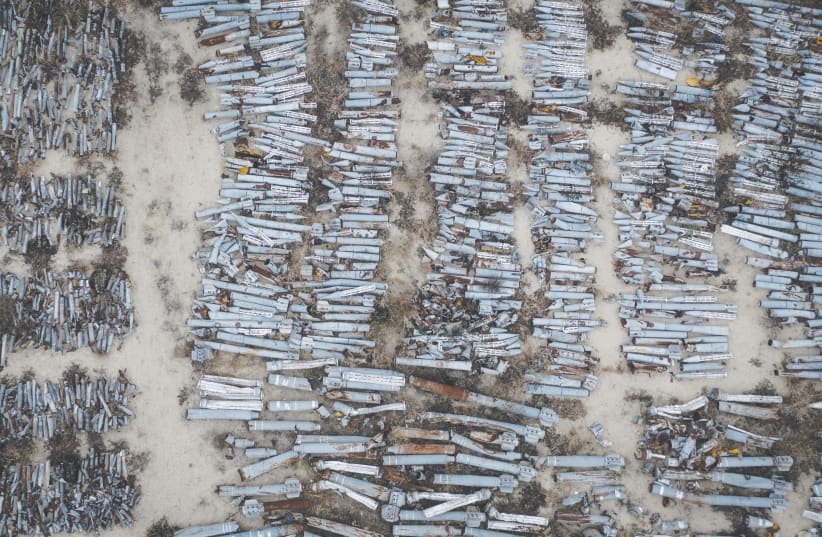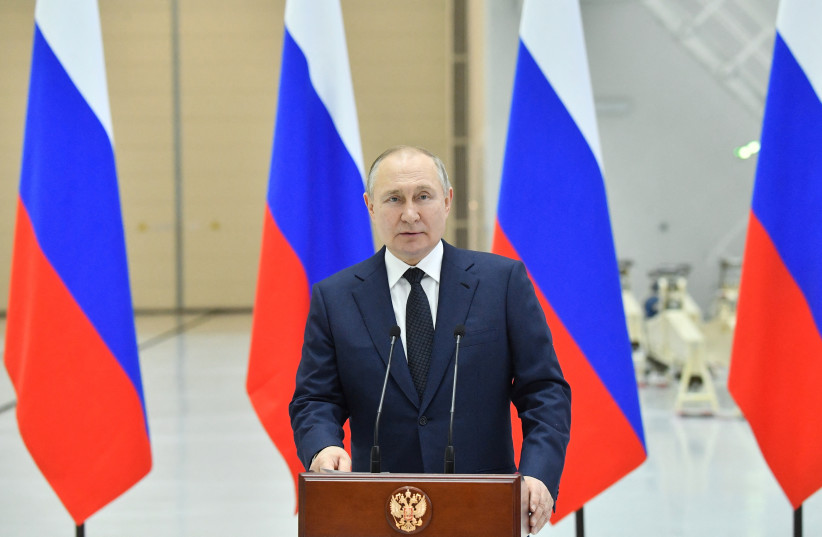Ukraine has held out for more than 300 days, stopping various Russian offensives, and launching its own counter-offensive. This week Ukraine’s leader Volodymyr Zelensky was in Washington, meeting US President Joe Biden and having important discussions about the war effort and US support.
The US is a major supporter of Ukraine, and Biden has helped rally the West to Ukraine’s cause. An unprecedented attempt has been made in Europe to rush defense systems to Kyiv. These systems have proven effective. Combined with Ukraine’s high morale and fighting spirit, the systems have stopped the Russians.
Now Russia is digging in for the long haul. This was likely Russia’s goal all along. If it couldn’t decapitate Ukraine in a rapid advance, it wanted to destroy the country. Moscow’s view is that Ukraine must be a client state, part of its “new abroad,” or Ukraine must be completely destroyed, the way the Romans destroyed Carthage. Salt will be sown into the soil, in a sense.
Ukraine-Russia War in for the long-haul
Moscow is using Iranian-supplied drones to target Ukraine’s infrastructure. It is purposely causing electric grid blackouts as the worst of winter arrives. From the beginning, Russia also set its sights on nuclear power plants and devastating areas of Ukraine that are important for production. Moscow also laid siege to Ukraine’s Black Sea ports and pressured Kyiv to make a deal, brokered by Turkey, to export grain.
A year ago, most people would not have imagined this scenario unfolding. Everyone knew Russia’s authoritarian leader Vladimir Putin was dangerous and that he was challenging the West. People knew he had already invaded Ukraine in 2014, but in that time, Russia had used the pretense of Ukrainians seeking to create secessionist states in the East as a pretext.
Russia occupied Crimea but quickly carried out a referendum that seemed to show many people there preferred Russian rule. Indeed, Crimea was an area that had changed hands in the past, so Russia could lay claim. But what about the Donbas, the area of Luhansk and Donetsk. Russia said these are Russian-speaking areas and they don’t like being under Kyiv’s control.
Russia had engineered this division of Ukraine. It had tried to strong-arm Ukrainian leaders ever since the collapse of the Soviet Union. For instance, a Ukrainian opposition leader, Viktor Yushchenko, was poisoned during a 2004 presidential election campaign. He was a pro-Western leader and a threat to Moscow.
Former Ukraine leader Yulia Tymoshenko was also jailed for several years, a sentence she said was politically motivated. Russia felt it had succeeded when Viktor Yanukovych came to power in 2010. He was considered more sympathetic to Russia.
However, in 2013, protests against his rule broke out and he led a crackdown on them, which eventually resulted in him fleeing the country. For pro-Moscow voices, this was a “coup,” but for supporters of Ukraine’s independence from Russia’s grasp, and for pro-Western voices, this was a revolution. Soon, Russian tanks were on the move and Crimea was being annexed and separatists had taken over parts of eastern Ukraine. A war began.
The war that broke out in 2014 was largely seen as a “frozen” conflict, where Russia would control two failed fake states it had helped set up in eastern Ukraine. This would be a replay of what Russia did to Georgia and its role in other places. Most did not think Russia was intent on sending tanks into Kyiv, like the Soviets had done in Hungary in 1956.
US warnings about the Russian invasion picked up pace in the fall of 2021. Biden already had a lot of background relating to Ukraine. For some on the Right in the US, this has tarred the conflict. This is because they see Ukrainian issues as tied to the Biden-Trump election.
It’s more complicated than this. Pro-Russian and pro-Western Ukrainian interests had been working in Washington for years. Both US political parties were linked to this. Nevertheless the fact that a phone call by Donald Trump to Zelensky had become part of a reason to impeach Trump and left lasting scars.
Putin’s decision to invade Ukraine was likely motivated by several factors. He had already gotten away with the 2014 invasions and he had sent troops to Syria, helping the Syrian regime cement its rule. Russia was also involved in Libya and several other conflicts in Africa.
Although Moscow knew it was facing more critique in the West, it also felt the West was permanently divided. Russia had been able to get Germany under Angela Merkel to appease its bullying. European countries were rushing to hook up their gas grid to Russia and making themselves dependent.
Russia had divided NATO by working with Turkey and selling it S-400s. Meetings with Turkey and Iran suggested Russia had the winning hand in Syria, and meetings with China and others at the SCO and CICA forums suggest a new world order was emerging.
The US withdrawal from Afghanistan in the summer of 2021 appeared to show the Americans were a broken reed; a semi-failed state. Putin only had to look online to see the pro-Russia memes that floated around of him riding bears and fishing to believe that a weakened West now admired Moscow’s strength.
The pandemic had also caused chaos, and the Biden election victory meant that time was ticking in terms of how long the window of opportunity would be open before the West got its act together again.
RUSSIA BELIEVED it would be kicking in a rotten door when it invaded Ukraine. It believed Russian speakers would welcome the Russian troops. Moscow didn’t even hide its troop movements. It assumed the West would cave in, as they had with things like Bashar Assad’s use of chemical weapons.
However, for many Western states Ukraine represented a redline. While they had been willing to accept a ceasefire in 2014 and they didn’t mind Crimea being annexed, the West tends to see the attempted destruction of a country as a redline.
This was also the case with Saddam Hussein’s invasion of Kuwait. He miscalculated the depth of Western resolve. Hitler did the same in 1939 with the invasion of Poland. The West doesn’t want war, but if you push the democracies far enough, they will give you war. And war is what Putin got.
From the first days of the offensive it became clear that Russia’s attempt was a kind of “thunder run” into Kyiv. This tactic had brought the Americans to Baghdad relatively quickly in 2003, why wouldn’t Putin’s new model army be able to accomplish the same?
Indeed, Putin had reformed Russia’s armed forces. He had modernized their equipment, and many units, such as the airborne forces, were believed to be crack military units. In contrast Ukraine’s army was thought to be a hodgepodge of units using different types of weapons; some trained in Western tactics, some rooted in the Soviet era.
Russia sent helicopters to seize sites near Kyiv and sent forces from Belarus, a client state of Putin, to attack Kyiv from its exposed northern flank.
Kyiv hadn’t prepared well for this initial invasion, the majority of its regular infantry forces were pinned down in the Donbas front, and it hadn’t mobilized sufficiently. The West assumed Kyiv would fall and most Western countries had withdrawn diplomatic staff further west to Lviv, or across the border to Poland.
It appears Russia and the West believed the same thing: Kyiv would fall, Zelensky would flee and a rump Ukrainian state would be set up in Lviv.
But Zelensky was no Ashraf Ghani. Instead of running away with planes full of money, he stayed in the capital, moving locations and appearing on short broadcasts to show he was still there.
It became clear quickly that Ukraine would never surrender and that even if it couldn’t hold all its front lines, under blows from Russia across thousands of kilometers of front, it would hold on.
Russia quickly shifted from trying to get to Kyiv to massacring Ukrainian civilians and destroying Ukrainian infrastructure. Massacres were carried out north of Kyiv in places like Bucha.
The pride of Ukraine’s air transport, the massive Antonov AN-225 Mriya, was destroyed in its hangar. In the south of Ukraine, Russian forces devastated Mariupol. The city was the headquarters of the Azov battalion, a right-wing Ukrainian volunteer force that Russia particularly despised. Azov fighters held out in an epic battle, but in the end, Russia, using Chechen and other fighters, destroyed the city and forced the fighters to surrender. Some were later released in a prisoner deal.
The destruction hardened Ukraine’s resolve. Thousands of foreign volunteers flowed into Ukraine, including many Westerners with military experience. Some men who had served fighting against ISIS packed up body armor and went to Kyiv.
By the summer and fall, Ukraine was launching offensives with Western weapons, finally making an impact on the front, with Western intelligence-sharing and advice also playing a key role.
For Zelensky in Washington this week, he can take pride in the first 300 days of Ukraine’s resistance. Now he will have to lead the country through the next 300 days and see if the Russians can be pushed back and some kind of agreement made that will end the war.

